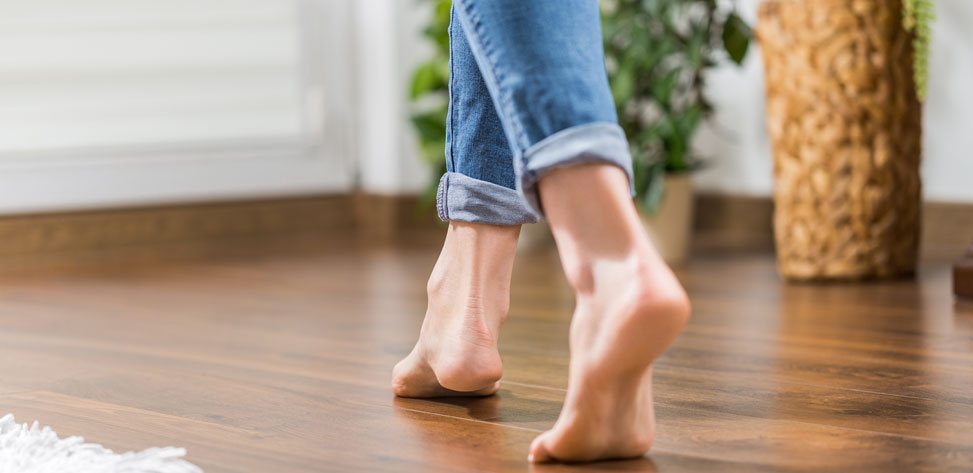Treat Your Feet Right And They’ll Remain Healthy
When’s the last time you told your feet, “I Love You”? Well this week is the perfect opportunity. August 17th is National I love My Feet Day and at Harford Lower Extremity Specialists we have a few gifts to suggest to reward your feet for all the hard work they do for you each and every day.
Pedicure—at home or at the salon, a pedicure pampers your feet and leaves them extra pretty for showing off in summer sandals. If you’re doing your own, start with a soothing soak. Try mixing 1 cup of Espom salts, 1 cup of sea salt, 2 cups of baking and several drops of the essential oil of your choice (peppermint, lemon or lavender are all good). Store in an airtight jar and place ¼ of a cup in a basin of warm water for the soak. Next, trim nails (straight across and not too short to avoid ingrown toenails). Gently push back cuticles. Dry feet completely and apply a sunny summer nail polish. If you choose a professional pedicure be sure the salon you choose is licensed by your state cosmetology board and sterilizes tools properly between patients (or, better yet, bring your own nail tools).
Foot Massage—a foot massage can improve circulation and it just feels so good! Use a rich, emollient moisturizer to prevent dry skin and heel cracking. For additional therapeutic benefits consider a reflexology massage by a certified practitioner.
A Podiatric Checkup—getting a foot check up with one of our podiatrists, Dr. Howard L. Schultheiss, Jr. can have several benefits. First, you’ll find out if there are any problems with your feet that need addressing. Treating foot problems in their earliest stages usually means less invasive treatment and quicker results. The foot doctor can also make recommendations for shoe designs and styles that will best suit your individual feet and give you tips on how to best care for your feet. To make an appointment, contact our Bel Air office by calling: 410-836-0131.
New Shoes—did you know that one of the best things that you can do to improve the health of your feet is to buy those good quality, supportive shoes? Don’t skimp when it comes to quality of your footwear. Choose shoes made of natural materials such as leather and canvas that breathe and allow air to circulate freely. Look for styles that have roomy toe boxes and limit heel height to reduce pressure on your toes and forefeet. Spend the time to get your foot professionally measured and then try on several pairs of shoes and walk around the store in them to find the most comfortable pair.
So take a moment to appreciate your feet today and say thank you for all they allow you to do!
If you’re a runner these rules are even more important, but you’ll also need to ensure you are wearing the right kind of shoes or you could risk chronic conditions and serious injuries down the road.
Shopping for Running Shoes
Shoe size is not the only consideration when shopping for running shoes. You should also consider buying a shoe design that complements your foot type. The right shoe helps improve a runner’s performance while preventing possible foot injuries.
A visit to the podiatrist can help you identify your foot type. This can be a good basis for selecting the right type of running shoes. Dr. Howard Schultheiss is a podiatrist who can help identify your foot type and give you advice on which running shoes would work best for you.
Types of Feet
- Neutral foot – the most ideal type of foot type. People with neutral foot will show footprints with a small inward curve no more than an inch. The foot rolls inward when performing load bearing activities. This form provides excellent stability when walking. It combines stability with shock absorption especially when running. People with a neutral foot structure have shoes with equal wear patterns.
What running shoe to wear?
Shoes that have excellent stability properties. This is needed for cushioning high impact activities and controlling pronation. The shoe’s midsole should be made from materials that limits excessive movement while providing additional cushion.
- Shoes for Flat Feet – a flat foot is suspected if your footprint does not show any visible inward curves or when the whole foot is visible. There is an increased stress on the inner foot structures as the foot rolls inward and flattens especially during load bearing activities. People with Flat Feet have decreased stability when walking. Shoes are also more likely to wear at the inner side.
People with Flat Feet are advised to wear shoes with motor control functionality. This shoe is less flexible and limits inward foot movements. You should look for shoes with extra support for the midsole.
- Shoes for High-Arched Feet – inspection of your footprint shows a clearly visible arch between the ball of the foot and heel. If a gap is observed between the heel and ball, then this is a clear indication of a high arched foot. People with high arched foot have more weight concentrated at the outside part of the foot. Shoe wear is also more prominent at the outer side of the shoe.
Shop for shoes with excellent cushioning. This will help to reduce shock from high impact activity. The midsole in particular should be softer and flexible.
Running is an excellent activity for keeping our body in shape, but this should not be done at the expense of our feet’s health. Getting the right type of running shoes is a simple way of preventing foot injuries.
At Harford Lower Extremities Specialists located in Bel Air, MD, we specialize in helping runners with foot disorders. To schedule an appointment call (410) 836-0131.

